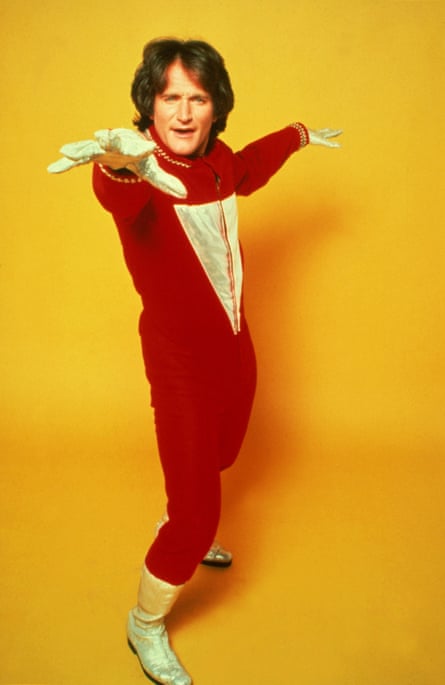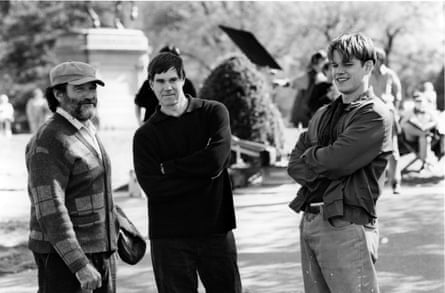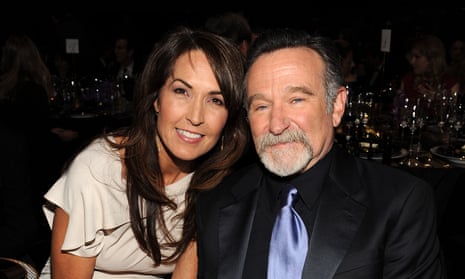After Robin Williams died in August 2014, aged 63, a lot of people had a lot of things to say about him. There was the predictable speculation about why a hugely beloved and seemingly healthy Hollywood star would end his own life, with some confidently stating that he was depressed or had succumbed to old addictions.
Others talked, with more evidence, about Williams as a comic genius (Mork & Mindy, Mrs Doubtfire, The Birdcage, Aladdin); a brilliant dramatic actor (Dead Poets Society, Awakenings, Good Will Hunting, One Hour Photo); and both (Good Morning, Vietnam; The Fisher King). One thing everyone agreed on was that he had an extraordinary mind. Comedians spoke about how no one thought faster on stage than Williams; those who made movies with him said he never did the same take twice, always ad-libbing and getting funnier each time.
Williams knew this about himself. In Marina Zenovich’s 2018 HBO documentary about Williams, Come Inside My Mind, we hear an old interview in which he is asked if he has any fears. Williams replies: “I guess I fear my consciousness becoming, not just dull, but a rock. I couldn’t spark.” It wasn’t until after he died that doctors were able to see that Williams’s worst fears had come true: the autopsy suggested that he had suffered from severe Lewy body dementia (LBD), more commonly referred to in the UK as dementia with Lewy bodies.
Talking to me from her home in Marin County, California, Williams’s widow, Susan Schneider Williams, tells me: “The doctors said to me after the autopsy: ‘Are you surprised that your husband had Lewy bodies throughout his entire brain and brain stem?’ I didn’t even know what Lewy bodies were, but I said: ‘No, I’m not surprised.’ The fact that something had infiltrated every part of my husband’s brain? That made perfect sense.”
Lewy bodies are abnormal clumps of protein that gather in brain cells and are thought to be responsible for 10% to 15% of dementia cases. People with LBD tend to experience, among other things, anxiety, memory loss, hallucinations and insomnia, and these symptoms are generally accompanied or followed by Parkinson’s symptoms. Since getting that diagnosis, Schneider Williams has made it her mission to correct misassumptions about her husband’s death, to educate others about this still relatively little known brain disease, and to find out what her husband endured while he was – unbeknownst to either of them – suffering from LBD.
So questions about Williams the celebrity are greeted by her with barely suppressed frustration (“Was I a fan of his? Um, I’m not really a fan of anybody”), but when I ask about the crossovers between LBD and Parkinson’s, she literally bounces in her seat with excitement: “OK, that’s a great question!” she says, launching into a detailed explanation of the relationship between Parkinson’s, LBD and Alzheimer’s, and how LBD can often be misdiagnosed as one of the others. When she first had the idea of making a movie about LBD, she pitched it as a straight science film (“the director laughed”). So she compromised and made Robin’s Wish, a very affecting documentary about her husband’s experience of the illness. “If my husband weren’t famous I would not have put myself through this. But there were so many misunderstandings out there about what had happened to him, and about Lewy bodies. So this felt like the right thing to do,” she says.
Schneider Williams is neither a neurologist nor a film-maker but an artist and, as if to prove her bona fides, behind her is a canvas and easel, all set up. “Robin and I loved to go to museums together. He was a big history buff, so he would bring the history and I would bring the art side and we would double our fun. People tend to assume that the guy he was on stage was the guy he was at home, and let me make it clear: I would never marry somebody like that,” she says with emphasis.
So he wasn’t riffing in different voices while making soup for lunch?
“Definitely not. The man at home, my husband, he was quiet, contemplative, an intellectual. The standup and acting, that was his work.”
Schneider Williams met Williams in late 2007, when she happened to stop in at the local Apple store. “I walked in and saw this man and I thought: ‘I think that’s Robin Williams.’ Then on my way out I happened to look at him again and he was smiling at me and something inside me said: ‘Oh, just go over and say hi.’ He was wearing camouflage print so I said: ‘How’s that camo working out for you?’ And he said: ‘Not too good – you found me.’” Four years later they got married, his third marriage and her second, and they lived in Marin County, with her two young sons from a previous relationship. Just two years later, the symptoms started.
Initially, Williams complained of stomach pains. Then his hand started trembling and he had terrible insomnia. Even more noticeable to Schneider Williams was his spiralling anxiety. “It was very out of character for Robin to be so paranoid. And that was the start of this 10 months drumbeat of increasing symptoms, and the thing with LBD is the symptoms don’t come all at once – they change. So they’re incredibly confusing to the patient and caregiver,” she says.
Some of the most moving parts of Robin’s Wish are the interviews with people whom Williams worked with towards the end. David E Kelly, who created the sitcom The Crazy Ones, which Williams starred in, describes him having to hide his tremoring hand in his pocket. Shawn Levy, the director of the Night at the Museum franchise, recalls Williams saying to him: “I’m not me any more”, adding: “His brain was not firing at the same speed, the joy wasn’t there.”
In early May 2014, Robin was diagnosed with Parkinson’s, and he started to let his children know (he has one son, Zak, from his first marriage, and a daughter, Zelda, and son, Cody, from his second). But Parkinson’s didn’t really explain the paranoia, the delusional looping, the mild depression and the anxiety, most of which, Schneider Williams says, were being treated as “satellite issues”, as opposed to part of an interconnected neurological problem. Williams’s behaviour was getting so extreme that he and his wife made the decision to go to a neurocognitive testing facility. A week before they were due to go, Williams killed himself. “I think he didn’t want to go. I think he thought: ‘I’m going to get locked up and never come out,’” Schneider says with a catch in her voice.
After Williams died, it was widely reported that he had been suffering from depression, alcoholism, or both. To Schneider, this shows “how we as a culture don’t have the vocabulary to discuss brain disease in the way we do about depression. Depression is a symptom of LBD and it’s not about psychology – it’s rooted in neurology. His brain was falling apart.” Williams had struggled with addictions in the past, but Schneider Williams says that wasn’t the problem this time.

He had briefly checked into a rehabilitation centre in 2014, but that was, she says, “to take time out, do some meditation, go deeper into the recovery work. Robin had been clean and sober for eight years when he passed.” (In Dave Itzkoff’s 2018 biography of Williams, Wendy Asher, a friend, confirms addiction wasn’t the problem: “This wasn’t that. This was a medical problem. Susan thought everything would be fixed through AA, and it just wasn’t true.”) Schneider Williams continues: “It infuriated me when the media said he’d been drinking, because I know there are recovering addicts out there who looked up to him, people dealing with depression who looked up to him, and they deserve to know the truth.”
Ever since his breakthrough as the gentle alien in Mork & Mindy, Williams sparked a fondness in the public that came closer to love. News of his passing caused a shudder of global grief that went far beyond the usual response to a celebrity death. Partly that came from the shock. But it was mainly to do with Williams. Whereas other wildly successful comedians tend to come across as prickly, unhinged or both, Williams always had an extremely endearing sweetness to him – a vulnerability but coupled with such intelligence and self-awareness that he seemed both sage-like and oddly relatable. His epigrams about addiction (“Cocaine is God’s way of telling you that you have too much money”) and depression (“Remember, suicide is a permanent solution to a temporary problem”) are so beloved they have become adages.
Julie Kavner, best known now as the voice of Marge Simpson, worked with Williams in the films Awakenings and Deconstructing Harry. “Honest to God, walking down the street with Robin was like walking with Mother Teresa, the way people would react to him,” she tells me. “I remember once we were walking through the East Village in New York while shooting Deconstructing Harry and no one asked him for a photo or autograph. They would just come up to him, really calm, and all they wanted to do was give him a high five, or touch him. His spirit was just so out there, and people wanted to thank him. I’m about to cry just thinking about it.”

Gus Van Sant, who directed Williams in Good Will Hunting, had the same experience with him: “People were just so happy to see him. They were like: ‘Oh, it’s you!’ and hug him without even asking. I’ve never seen that with any other famous person I’ve worked with. Sean Connery [who Van Sant directed in Finding Forrester] would have been like: ‘Dear God, have some decency!’ But Robin would hug them back. He had that soft side, and he was receptive to people and things around him. I remember once going with him to an art gallery and he would really take in the ideas in the pieces of art. He’d be like: ‘Oh, look at this! And this!’ He was like a kid in a candy shop.” Van Sant echoes Schneider Williams in describing Williams as “very serious”, but adds: “Although he would regularly break into comedy routines, just to make the cast and crew laugh.”
“When we were making Awakenings, we were filming in the deserted part of a mental hospital, and often shooting through the night,” says Kavner. “And there was this TV in the corner on mute, and Robin, between breaks during the scenes, would go off on a riff, inventing dialogue on the TV show, entertaining everyone at 3am, whatever time. It was a very tough role that he did a phenomenal amount of research for, but he didn’t keep to himself between takes – he was out there, giving to everyone.”
After he died, doctors were shocked by the extent to which the Lewy bodies had gathered in Williams’s brain, with one describing it as one of the worst cases he had ever seen. Schneider Williams is certain the LBD led to her husband’s suicide; professionals in dementia that I spoke with, while sympathetic to Schneider Williams, say it’s impossible to make a direct link between the two. “LBD can be a devastating diagnosis, but if people get the right support and treatment, then they may be able to have a good quality of life for a number of years,” Rachel Thompson from Dementia UK and the Lewy Body Society told me. Sadly, Williams never got the diagnosis, therefore never got the treatment, and so found himself, for reasons he couldn’t understand, unable to give as much as he wanted to the people around him.

“But Robin still tends to show up when I need him. About an hour before this interview I saw robins in the yard,” says Schneider Williams. “But when he’s not there, I think of my friend, my love, and I miss him.”
This article was amended on 2 January 2021. Robin Williams had been clean and sober for eight years when he died, rather than six as an earlier version said. And due to a misunderstanding, Susan Schneider Williams was quoted as having seen “him in the yard” just before the interview, when the intended reference was instead to “robins in the yard”. This has been corrected.
Robin’s Wish is released digital and on demand in the UK on 4 January. More information on the American Brain Foundation.
